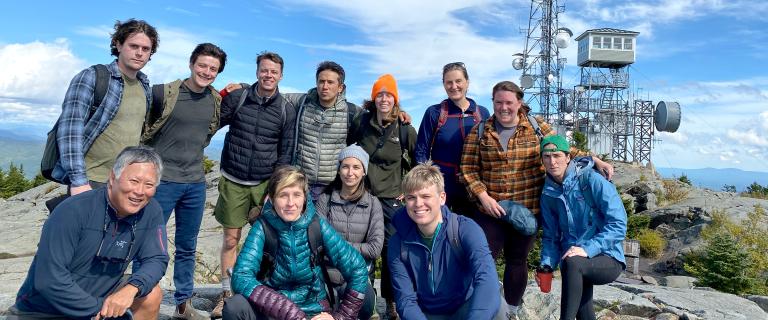
Dean Takahashi (bottom left) and the CC Lab team on the summit of New Hampshire's Mount Kearsage in September 2022

Dean Takahashi (bottom left) and the CC Lab team on the summit of New Hampshire's Mount Kearsage in September 2022
Now, in its fourth year, the Carbon Containment Lab founded by Dean Takahashi, former senior director of the Yale Investments Office, has collaborated on dozens of projects — both within Yale and externally — aimed at supporting carbon containment strategies with large-scale implementation potential. Recently, CC Lab, formerly based at the Yale School of the Environment, spun off from Yale University to become an independent nonprofit. Takahashi recently spoke to YSE News about CC Lab’s progress, its plans to continue its strong collaborations across Yale as an independent entity, and its ambitious goals for 2030 and beyond.
The origins of the CC Lab lie with our work trying to help Yale meet its 2020 climate commitments. It was clear early on — ever since former Yale President Richard Levin set the goal in 2005 — that the university would need to buy carbon credits to meet the target. At the time, the university did not have a process for buying credits. It also was quite difficult to identify which credits were representative of real, measurable emissions reductions.
I was still working at the Investments Office, but volunteered to start Yale’s Carbon Offsets Working Group, which helped identify high-quality carbon credit projects for the university to support. Then, in 2018, the Intergovernmental Panel on Climate Change’s “Special Report on Global Warming of 1.5°C” stated that in addition to dramatically reducing, and eventually eliminating, fossil fuel use, large-scale removal of carbon from the atmosphere would be needed to achieve the world’s climate goals. It was clear that we could take lessons learned from our work at Yale and apply them to the national and global stage.
The CC Lab also emerged from my own curiosity about how wood can store carbon durably. I’ve always loved the outdoors and have been fascinated by the ways that wood at the bottom of streams, in peat bogs, or even in Japanese shrines can remain intact for centuries. Initially, I was curious about how we could expand and support opportunities to store carbon in wood, but, obviously, now the CC Lab’s projects include much more than that.
I’m most proud of our team. Our staff and students have been incredible in their ability to learn about and respond to new climate solutions. I especially appreciate their open-mindedness to new ideas. Many of our current projects emerged from students’ personal or academic interests.
One major area where we’ve bolstered our expertise is on short-lived climate pollutants such as methane and hydrofluorocarbon refrigerants. These gases are much more potent than CO2 and have outsized effects on near-term atmospheric warming. Supporting projects mitigating these gases will be critical in reaching the CC Lab’s 2030 quantitative goals. Much of our learning in this arena has come from our student interns and analysts, as well as from our friends at the Environmental Defense Fund such as Fred Krupp, Steven Hamburg, and Len Baker. We learned a lot from them about the ample opportunities to mitigate these gases at low cost — findings that have been critical to building out our project portfolio.
Yale has been a fantastic first home for us. Now, as a fully-fledged and more mature organization, we’re seeking more flexibility in deploying our time and resources to our projects. We think that spinning out, all while maintaining strong ties to Yale and the academic community, will be the most effective way of achieving that.
We have received encouragement from advisors, donors, and collaborators over the past several years to explore an independent structure. They have enthusiastically backed our spin out, and we’re so lucky to have their continued support. It is important to emphasize though that we will stay actively engaged with Yale, continuing to partner with faculty and students at YSE and across the university.
One of my favorite parts of the CC Lab has been working closely with students in Yale College, the School of the Environment, and the other professional schools. Since our founding, we’ve employed dozens of students each semester and summer, several of whom have joined our team as analysts after graduation. Students at Yale are extraordinarily talented, creative, and energetic, and we hope to continue to be a place where students can contribute to climate work during and after their time at Yale.
I’m very confident in these goals. They remain ambitious, but we are well on the way to getting there. Our active projects and project pipelines have expanded tremendously in scope and location since we started in 2020. Much of our work now, including on short-lived climate pollutants and gasification, wasn’t even on our radar back then. These projects involve collaborators around the world. Our ability to take up new projects and partner with world-class organizations, companies, and researchers will be critical to our continued success.